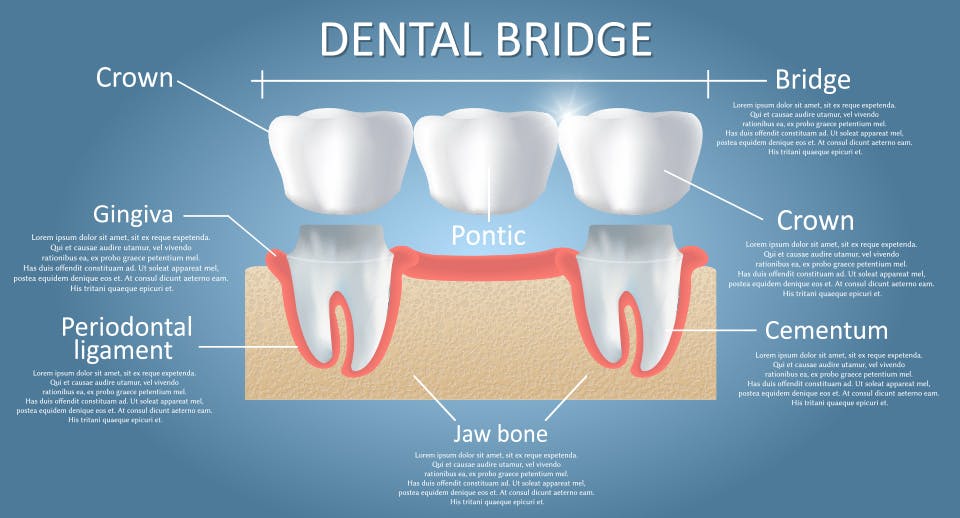Dental Bridges – Types and Benefits
What Is a Dental Bridge
Missing one or more teeth is a concerning dental issue. In fact, the average adult aged between 20 and 64 has three or more decayed or missing teeth. Losing teeth can cause numerous problems. Not only can it affect how you look, speak and eat, and gaps in your smile can also cause your remaining teeth to shift places in your mouth. This change is a result of missing teeth and different chewing stresses put on the teeth.
Instead of getting new dentures to replace missing teeth, one option is a dental bridge.
What Is a Dental Bridge Made Of?
You may be wondering, 'what is a dental bridge?' The answer is simple. A dental bridge is a fixed prosthetic device that fills (or ‘bridges’) the gap left by missing teeth with artificial teeth – also called ‘pontics’. These artificial teeth are generally made from gold, alloys or porcelain. Unlike dentures, which you can take out yourself, fixed dental bridges remain in your mouth and are not removable. If there is a problem, then your dentist will have to remove them. So, it is critical to keep this bridge clean—brushing daily and flossing under and around abutment teeth or other dental aids that your dentist advises you use. Also, make sure to keep up your routine dentist visits so they can make sure everything is working as it should.
Dental bridges are not the same as dental implants, which are artificial teeth made from porcelain that are secured onto natural teeth that are drilled down to resemble a 'peg.' The bridge is made outside of the mouth and then placed onto the teeth adjacent to the space. Dental bridges stay in place because they are attached to adjoining natural teeth. If you are weighing up the pros and cons of having a dental bridge vs. an implant, several factors will determined by your dentist and discussed with you prior to proceeding with treatment.
Dental Bridge Costs – Dental Bridge vs Implant
The price of a dental bridge can be expensive, but costs can also vary depending on several factors including:
- Whether the bridge is made in an office or a lab
- The type of dental bridge and number of teeth needed
- The bridge material
- What type of dentist specialist is doing the work (prosthodontist or general)
- Whether insurance will cover any or all of the work
Before you go ahead with a procedure, ask your dentist for a treatment plan with detailed details on procedure prices. Insurers may cover the costs in some cases, so speak to your insurance provider.
Dental Bridge Types
Traditional Bridge
The most basic bridge is the traditional type – suitable if you have natural teeth on both sides of the gap left by the missing tooth or teeth. To attach a traditional bridge, the adjoining natural teeth must have their enamel removed and replaced by dental crowns (or ‘caps’) that fit over them. The artificial teeth are then attached to these supporting natural teeth by your dentist.
Cantilever Bridge
A cantilever dental bridge is similar to the traditional bridge type, except that the artificial tooth is supported on only one side, rather than both. The main advantage is that you only need one strong tooth to attach it to; however, this may weaken the supporting tooth over time.
Maryland Bridge
This type of dental bridge is supported by metal or porcelain ‘wings’ bonded with resin to the backs of the two teeth that are adjacent to the missing tooth. It is more common when teeth are missing at the front of your mouth and is considered to be a more conservative approach. However, this does fail far sooner than a traditional bridge.
Implant-Supported Bridges
These dental bridges are a useful type to consider when multiple teeth are missing and the gaps are not near each other. Instead of being attached to natural teeth either by crowns or a framework, these bridges are supported by dental implants that hold the bridge in place.
What Is a Dental Bridge Procedure Like?
Having a dental bridge fitted can typically involve several appointments depending on the type of bridge. Your dentist will first prepare the teeth on either side of the gap of your missing teeth. Your bridge will be attached to these prepared teeth later. Then, your dentist will take impressions of your existing teeth and the space between for the laboratory to create a custom-made bridge. However, some offices use 3D imaging to make an impression to send to the lab. Your dentist will also likely provided you with a temporary dental bridge to protect your exposed teeth while your permanent one is being made.
In following visits, the bridge will be fitted onto your teeth, adjusted if needed and cemented in place. This may take a few visits after your first fitting to ensure your dental bridge is comfortable and adjusted well.
Pros of Dental Bridges
The benefits of a dental bridge are not just cosmetic. Apart from restoring your smile, the bridge can strengthen your bite, making chewing easier. Filling out your missing teeth can stop other teeth moving into the gap, and help prevent tooth decay by reducing harmful plaque and tartar buildup in hard-to-reach places that are caused by shifting teeth. It will also help maintain the shape of your face, which can change when you are missing teeth.
Taking Care of Your Bridge
When looked after properly, most dental bridges will last more than 10 years. Follow these simple steps to best care for yours:
- Brush your teeth: Brush carefully after every meal with toothpaste and a soft-bristled toothbrush.
- Floss daily: Talk to your dentist about the best way to floss with a dental bridge.
- Visit your dentist regularly: Aim for a dental check-up every six months or more, depending on what your dental professional recommends.
- Avoid sugary and starchy foods: These foods can cause harmful acids to build up in your mouth, which can eventually cause cavities and tooth decay if not removed regularly by daily brushing and flossing as recommended by your dental professional.
- Avoid hard and sticky snacks: Foods like popcorn kernels, hard or chewy candy, caramel, ice chips and nuts can damage your bridge.






